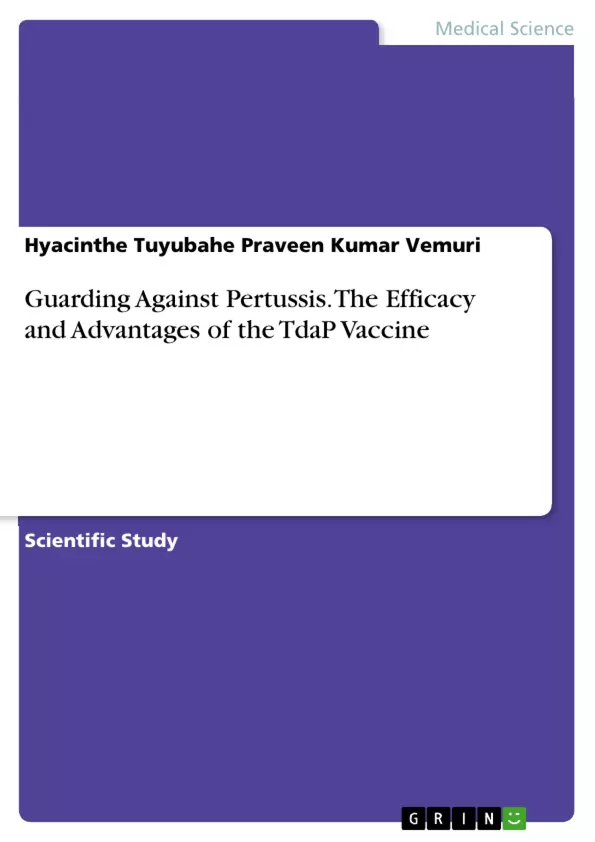This paper aims to elucidate the importance of TdaP vaccines in the prevention of pertussis, highlight the increased risk of this disease in adults, and underscore the benefits of using acellular vaccines over whole-cell vaccines.
This text underscores the escalating threat of Pertussis (whooping cough) in adults and its lethal repercussions on infants with lesser immunity. This has led to innovations in vaccine development, particularly the emergence of acellular vaccines like the TdaP vaccine that effectively combats Tetanus, Diphtheria, and Pertussis. This vaccine offers the advantage of fewer side effects compared to whole-cell vaccines and contains purified antigenic components of Bordetella pertussis obtained through various purification techniques.
The increased risk of pertussis in adults have become an important public-health issue. This contagious disease spreads to infants who have lesser immunity resulting in their death. Increased death rate caused the inventions of vaccinations to prevent this disease. Concerns regarding the safety of whole-cell vaccines used for pertussis treatment lead to the development of acellular pertussis vaccines like TdaP vaccines. This combination vaccine is 71-85% effective in the treatment of adults suffering from diseases tetanus, diphtheria and pertussis. These vaccines have limited side effects when compared to whole-cell vaccines as they contain purified antigenic components of Bordet Ella pertussis (Pertussis toxin, Filamentous hemagglutinin and Pertactin) that are obtained by the purification techniques Tangential flow filtration, Column Chromatography and Dialysis. These components are then formulated for purified vaccine production.
Inhaltsverzeichnis (Table of Contents)
- 2. INTRODUCTION
- 2.1 VACCINE:
- 2.1.1 HOW VACCINES ARE USED:
- 2.1.2 VACCINATION:
- 2.2 BORDETELLA PERTUSSIS
- 2.2.1 ABOUT BORDETELLA PERTUSSIS:
- 2.2.2 CAUSE OF DISESASE THROGH BACTERIA:.
- 2.2.3 TYPES OF PERTUSSIS VACCINE:.
- 2.2.4 PURIFICATION OF VACCINE
- 2.3 PERTACTIN (PRN)...
- 2.3.1ORIGIN OF PRN
- 2.3.2 STRUCTURE OF PRN.
- 2.4 FILAMENTOUS HEMAGGLUTION(FHA).
- 2.4.1 ABOUT FHA...........
- 2.4.2 NUCLEOTIDE SEQUCENCE OF FHA..
- 2.1 VACCINE:
- 3. REVIEW OF LITERATURE
- 3.1 AIM OF REVIEW:
- 3.2 MICROBIOLOGY OF BORDETELLA SPECIES:
- 3.3 MECHANISMS OF PATHOGENESIS:..
- 3.4 EPIDEMIOLOGY:.
- 3.4.1 Global burden of Pertussis
- 3.4.2 BURDEN OF PERTUSSIS IN INFANTS AND TODDLERS
- 3.4.3 BURDEN OF PERTUSSIS IN ADOLESCENTS AND ADULTS
- 3.4.4 TRANSMISSION DYNAMICS OF PERTUSSIS.
- 3.5 IMPACT OF PERTUSSIS.
- 3.6 POSTEXPOSURE PROPHYLAXIS AND THERAPEUTICS.
- 3.6.1 Nonmacrolide Treatments
- 3.7 IMMUNITY TO PERTUSSIS.....
- 3.8 VACCINES AND IMMUNIZATIONS..
- 3.8.1 DTP and DTaP Vaccines for Infants and Young Children ...
- 3.8.2 DIAGNOSIS.
- 3.8.3 TYPES OF VACCINES
- 3.9 PROTEIN PURIFICATION.
- 3.9.1 AIM OF PROTEIN PURIFICATION..
- 3.9.2 TYPES OF CHROMATOGRAPHIC SYSTEM.
- 4. MATERIALS AND METHODS.
- 4.1TANGENTIAL FLOW FILTRATION.
- 4.2 COLUMN CHROMATOGRAPHIC SYSTEM
- 4.3 DIALYSIS
- 5. PROCEDURE.
- 5.1 PROCESS FOR PT AND FHA PURIFICATION:
- 5.2 PROCESS FOR PRN PURIFICATION:
- 6. RESULTS
Zielsetzung und Themenschwerpunkte (Objectives and Key Themes)
This document delves into the purification process of specific components from Bordetella pertussis for the development of a pertussis vaccine. It explores the challenges associated with existing vaccines and the need for safer and more effective solutions. The study aims to develop a comprehensive understanding of the purification process, utilizing techniques like Tangential Flow Filtration, Column Chromatography, and Dialysis.- Purification of vaccine components from Bordetella pertussis
- Development of safer and more effective pertussis vaccines
- Evaluation of different purification techniques
- Understanding the role of Pertussis Toxin, Filamentous Hemagglutinin, and Pertactin in vaccine development
- The importance of public health and the fight against pertussis
Zusammenfassung der Kapitel (Chapter Summaries)
The document begins with a thorough introduction to the concept of vaccines and their role in preventing diseases. It dives deep into Bordetella pertussis, exploring its characteristics, the diseases it causes, and the different types of vaccines available to combat them. The chapter also delves into the purification of pertussis vaccines and explores the components like Pertactin and Filamentous Hemagglutinin. Following the introduction, the document reviews the existing literature on pertussis. It discusses the microbiology of Bordetella species, its pathogenesis mechanisms, and the epidemiology of pertussis, including its global burden and impact on various age groups. The review further analyzes post-exposure prophylaxis and treatment options, examines immunity to pertussis, and explores different types of vaccines, including DTP and DTaP vaccines for infants and young children. The chapter concludes by analyzing protein purification and its role in vaccine development. The document continues by detailing the materials and methods used in the purification process. It explores the Tangential Flow Filtration, Column Chromatographic system, and Dialysis techniques. The following chapter outlines the procedures for the purification of Pertussis Toxin and Filamentous Hemagglutinin, as well as the process for purifying Pertactin. The document concludes with the results obtained during the purification process.Schlüsselwörter (Keywords)
The primary focus of this document is on the development and purification of pertussis vaccines. Key areas of investigation include Bordetella pertussis, vaccine components such as Pertussis Toxin, Filamentous Hemagglutinin, and Pertactin, purification techniques like Tangential Flow Filtration, Column Chromatography, and Dialysis, and the impact of these vaccines on public health.- Quote paper
- Hyacinthe Tuyubahe Praveen Kumar Vemuri (Author), 2023, Guarding Against Pertussis. The Efficacy and Advantages of the TdaP Vaccine, Munich, GRIN Verlag, https://www.grin.com/document/1351272



